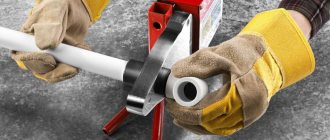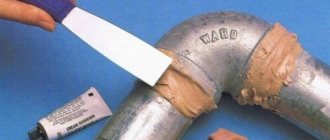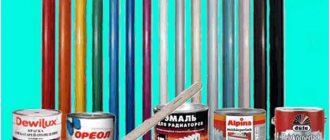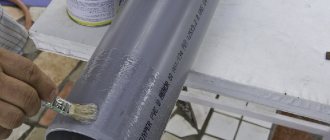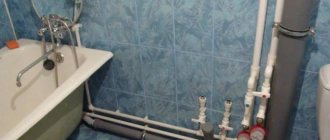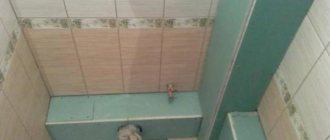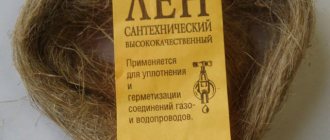New construction technologies for the installation of engineering systems, instead of conventional pipelines made of cast iron and steel pipes, offer much more profitable materials - polymer ones. For example, PVC pipes are increasingly used for sewer networks, polyethylene pipes for water supply, polypropylene pipes and fittings for heating systems. The main indicator is the internal diameter of polypropylene pipes; special attention should be paid to it.
Material properties
Polypropylene is a kind of thermoplastic polymer. It is made by combining (polymerizing) molecules of the derivative gas ethylene. International designation of polypropylene “PP”. Let's take a closer look at the properties and manufacturing technology of this new generation material.
Possessing unique resistance to alkaline solvents and aggressive substances, the material is widely used in the installation of any plumbing structures. Withstands low and high temperature conditions, they can vary from minus 10 to plus 100 C.
Advantages of plastic
Any structural element made from the above materials has the following advantages:
- Resistant to a variety of chemicals, for example, solvents or alkalis.
- Strength , allowing the part to be immersed in the ground at a distance of up to 16 m.
- a smooth surface inside , creating an obstacle to the formation of plaque.
- Low weight . With a length of one hundred centimeters, an element with a circumference of 110 mm weighs about 1.5 kg.
Types of polypropylene pipes and their purpose
Today we offer a huge range of these products. Before purchasing, you should pay special attention to the type of material. It could be as follows:
- reinforced;
- whole.
Based on the technical characteristics, we can safely say that they have a fairly wide range of applications. They are often used for:
- sewerage structures;
- transportation of toxic substances;
- water supply in the building;
- installation of the ventilation system.
Their service life is long, with proper operation it is 50 years. The age of the riser does not affect the functionality and technical characteristics; they are completely preserved.
Wiring diagram
The choice of pipe parameters depends on the type of water supply network. With a series (tee) connection, all water intake points are installed one after another. Due to the small number of key parts, the method allows saving costs on materials.
When turned on at the same time, due to weak pressure, little fluid will flow to the remote component. To neutralize the problem, you need to choose the correct pipe diameter. It is recommended to take elements whose parameters are one step smaller than the main system. The technique helps to increase the pressure in diversion structures.
Tee pipe routing Source posudachimodache.ru
The collector wiring diagram allows you to connect several water intake points in parallel to a source or main line. For each device, an individual line with a valve is assembled. The pressure remains stable during simultaneous operation.
When choosing the diameter of the pipes, they are based on the length of the parts and the characteristics of the pipeline. Installing a collector circuit consumes more materials. The throughput of a properly designed water supply system is not dependent on the number of bends and connected devices.
Collector wiring diagram Source myosu.ru
Marking of polypropylene pipes
The scope of application depends on the material used to make the product. The markings of the elements reflect their technical characteristics.
By pressure
Each material has its own characteristics; the main characteristic by which the area of application is determined is pressure. There are 3 main types - these are:
- for a warm floor system or conducting cold water into the house, part number N10 is used, you can also take a PN 10 pipe. Their pressure is not higher than 10 atmospheres, which allows substances to be carried out without problems;
- model PN25 has a structure that consists of several layers. It increases endurance. For this reason, this type is actively used for installing hot water supply systems in buildings of different heights. Withstands pressure up to 25 atmospheres.
- type PN20 or N20 has a pressure of 20 atmospheres and can withstand temperatures up to 85 - 90 degrees Celsius. Therefore, they are used for any plumbing work.
Pipes can be stored for quite a long time, but they should not be allowed to be near heating systems or devices with high temperatures. This may negatively affect the quality of the material.
Interesting! How to choose a water meter: its installation and saving options
Physico-mechanical characteristics
- Melting point: +149C (GOST 21553).
- Density: 0.9 g/cu.m. cm (GOST 15139).
- Yield strength (tension): from 24 to 25 N/kV. mm (GOST 11262).
- Tensile strength: from 34 to 35 N/kV. mm (GOST 11262).
- Elongation at yield point: 50%.
- Expansion coefficient: 0.15 mm/mmS (GOST 15173).
- Thermal conductivity (at +20C): 0.24 W/mS (DIN 52612).
- Specific heat capacity (+20C): 2 kJ/kgC (GOST 23630).
What determines the diameter of a polypropylene pipe?
The first question that arises before designing a polypropylene pipeline is the diameter. It should be selected in accordance with the results of hydrodynamic calculations. The point is to select the smallest allowable pipe size in a particular section. The calculation takes into account the operating pressure and circuit.
Diameter is a value indicating where certain tubes should be installed. If the internal diameter is large (40 - 200 mm), then such polypropylene pipes are used in the construction of structures intended for use by a large number of people (hospitals, saunas, hotels, large stores, entertainment centers).
Dimensions of metal products
Sewage pipes made of cast iron can be divided into several types based on their functionality:
- S.M.U. These products do not have a detachable connection, that is, both sides will be smooth;
- SME. A bell is installed at one end. The other side of the product is smooth.
The size specified in the marking characterizes the internal diameter. For example, the index DN 100 will mean that the parameter is 100 mm. In this case, the total volume of the product, including the walls, is 110 mm.
Table of diameters of polypropylene pipes
The level of transported substances is one of the main parameters that are worth paying attention to. If the indicator is not high, then installations of the type with a small cross-section are made. The higher the level, the larger the diameter of the riser. For smaller buildings, types with a cross section of 1.6 - 11 cm are used. The main characteristic is the internal diameter of polypropylene pipes, it is described in detail in the table.
| External diameter/mm | PN 25 Inner Diameter/Wall Thickness cm | PN 20 Inner Diameter/Wall Thickness cm | PN 10 Inner Diameter/Wall Thickness cm |
| 16 | — | 1,06/0,27 | — |
| 20 | 1,32/0,34 | 1,32/0,34 | 1,62/0,19 |
| 25 | 1,66/0,42 | 1,66/0,42 | 2,04/0,23 |
| 32 | 2,12/0,3 | 2,12/0,54 | 2,6/0,3 |
| 40 | 2,66/0,37 | 2,66/0,67 | 3,26/0,37 |
| 50 | 3,32/0,46 | 3,32/0,84 | 4,08/0,46 |
| 63 | 4,2/0,58 | 4,2/1,05 | 5,14/0,58 |
| 75 | 5/0,69 | 5/1,25 | 6,12/0,69 |
| 90 | — | 6/1,5 | 7,36/0,82 |
| 110 | — | 7,32/1,84 | 9/1 |
Size and place of application of PVC products
The production of polyvinyl chloride pipes is regulated by GOST R 51613-2000 , or the VSN 48-96 . For the production of pressure parts the specified GOST is used, and in the production of non-pressure parts the standard is applied.
According to the data given in the standard, the diameter of non-pressure PVC sewer pipes can be:
- 50mm.
- 90mm.
- 110mm.
At the same time, plastic pipes for sewerage, the dimensions of which in length range from 0.5 to 8 meters, have an internal wall thickness of at least 3.2 mm.
GOST R 51613—2000
Differences between pressure pipelines and non-pressure pipelines
The differences between pressure pipelines will be significant from the specified parameters of non-pressure systems. For example, the number of standard sizes of these products is 13 pieces. At the same time, PVC sewer pipes, diameter sizes range from 63 to 315 mm.
The presence of such a choice of sizes plays into the hands of construction organizations. However, the following pipe diameter options are often used:
- 7.5 cm. The product is used for making taps in bathrooms.
- 10 and 11 cm. Such parts are used for carrying out the external pipeline and riser.
- 20 and 30 cm. The products are used for drainage systems in industrial buildings.
Diameter of pipes - internal and external sewerage systems
Section of polypropylene fittings
Speaking about a polypropylene pipeline, one cannot fail to mention the fittings, which are responsible for connecting all its links and forming turns, bends and branches of the pipeline. These elements provide the most exact match, allowing you to implement any heating scheme in practice.
For polypropylene pipes, regular fittings or with a threaded brass insert are used. The first are connected to polypropylene plumbing by diffusion welding, the second are polypropylene, like metal pipes.
Today, the market offers fittings, the sizes of which vary over a fairly wide range, which makes it easy to select the appropriate sample. The choice of internal diameter of fittings for polypropylene pipes determines the operating conditions; it can be 20 or 50 mm.
There are two types of fittings - with and without threaded connections. Threaded fittings are removable and durable. Its type is selected depending on the operating conditions. For example, when connecting a storage tank, a removable threaded fastener is convenient, and when connecting a hose, it is a solid one.
For heating and water supply
There are several ways to supply water to your home:
- on the ground;
- along the top.
Models that have an internal circumference from 16 to 75 mm are suitable for this work.
If installation work is carried out inside a building, then it is better to use a product with an internal diameter of 12 to 32 mm in cross section. Fittings for polypropylene pipes with a cut characteristic of 2 - 4 cm are used for cold water.
When planning the installation of a hot water supply system, you should pay attention to products with a size of 0.2 to 1 cm.
The correct size of the product directly affects the thermal conductivity throughout the building. It is also important to remember that the water heats up to a high temperature, on average it is 100 degrees, so it is better to purchase reinforced models.
For sewerage
In recent years, most builders, when laying sewer systems, use products made from polypropylene. This is due to the fact that they have a lot of advantages and high endurance.
For the design of private houses, types with an external parameter of 32 - 75 mm are selected, for internal work 100 - 110 mm. On an industrial scale, tubes larger than 1.10 cm are installed.
For ventilation
Previously, the ventilation system was created from metal structures; today polypropylene material is preferred. The circumference of their sections varies from 1 to 3 cm if mains are laid for ventilation of the building.
Options
The standard marking for cast iron pipelines is from DN 50 to DN 400. Products that do not have sockets, that is, with smooth sides, have an increased margin of safety. Their length is three meters. SMU pipes can be produced in lengths of 15 cm or more.
The wall thickness of a cast iron pipe is almost identical to plastic products and is 4-5 mm. However, despite similar dimensions in length, wall thickness and diameter, the weight of the metal structure is 10 times greater than the weight of the plastic pipeline. For clarity, a meter of metal product will weigh about 15 kilograms. Accordingly, a plastic pipe of identical dimensions will weigh only 1.5 kilograms.
How to choose the right size of polypropylene fittings for your home line
Those who are faced with the purchase of risers for the first time do not know what internal diameter of a polypropylene pipe is required. Selecting all the design elements will not be any problem, since all products have special markings. All technical characteristics that are necessary for the work are indicated. The buyer only has to carefully select all the accessories according to the same parameters.
It is recommended to buy all elements from one manufacturer, then there will be no difficulties. If the manufacturer of pipes and fittings is different, then compatibility can be checked. You just need to try it on, insert the edge of one product into the other, if it fits tightly, then they fit perfectly.
Polypropylene is one of the best materials; it has many advantages. All designs have high strength and durability. They can be used for private cottages, as well as in apartment buildings.
Some important installation nuances
The installation of plastic pipes is somewhat different from their metal counterparts. In particular, during installation the following conditions must be observed:
- Polypropylene pipes do not bend at right angles; tees and fittings are used here to change the direction of the line.
- Plastic does not collapse under the influence of temperature changes: the pipe increases in length. Therefore, if the length of the pipeline section exceeds 10 meters , temperature compensators must be installed.
- Under the influence of high temperatures, pipes are subject to linear expansion, so rigid fixation of the pipeline inside wall structures is not allowed: thermal gaps must be left.
- For hot water supply, only reinforced products are used, which are less susceptible to linear expansion.
- Slight bending of the pipe is allowed. This can be done by heating the surface with a hair dryer (temperature about 140 degrees ).
It should be noted that storing plastic pipes in open spaces is not recommended. To protect products from direct sunlight, which destroys the structure, canopies must be installed.
